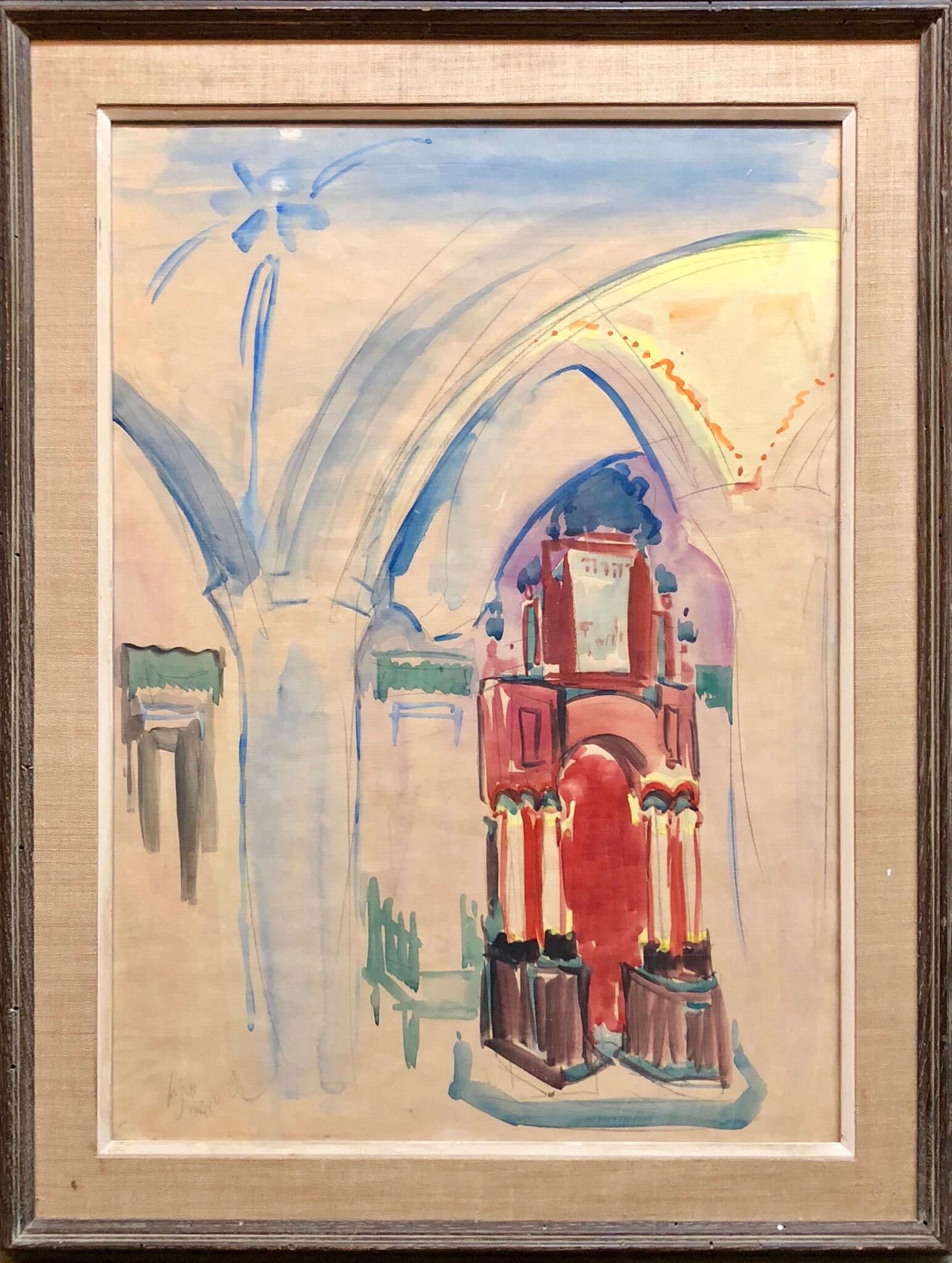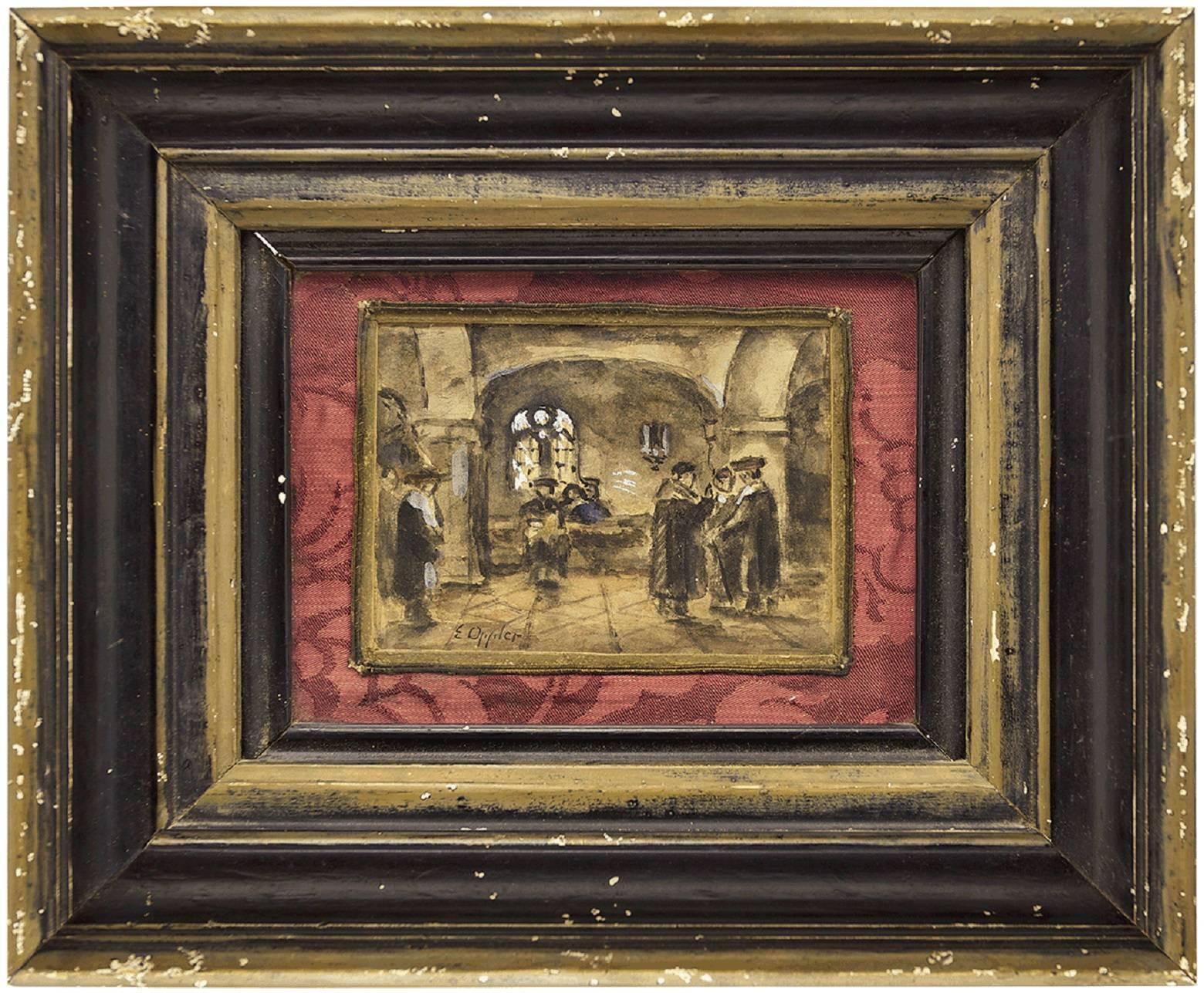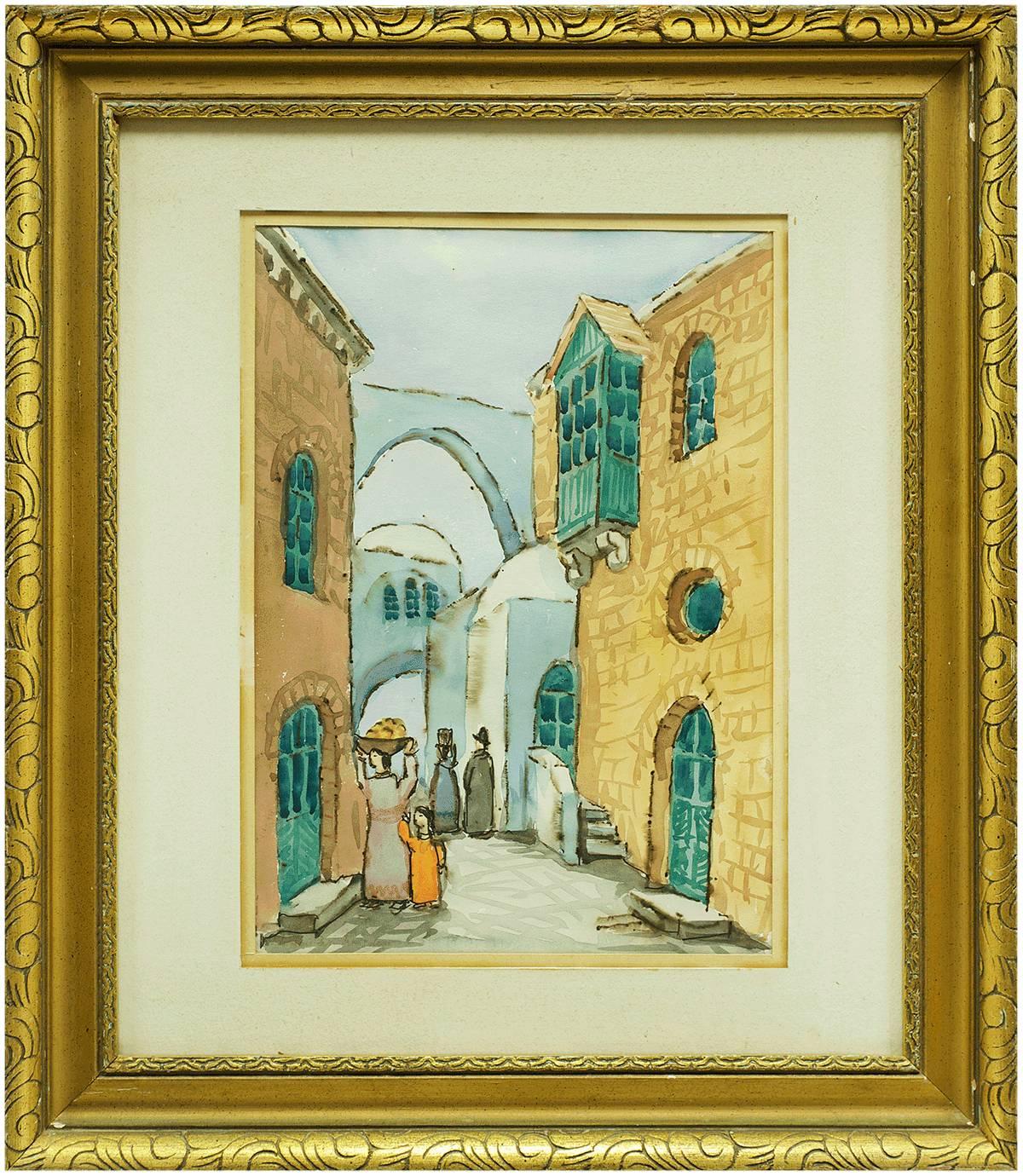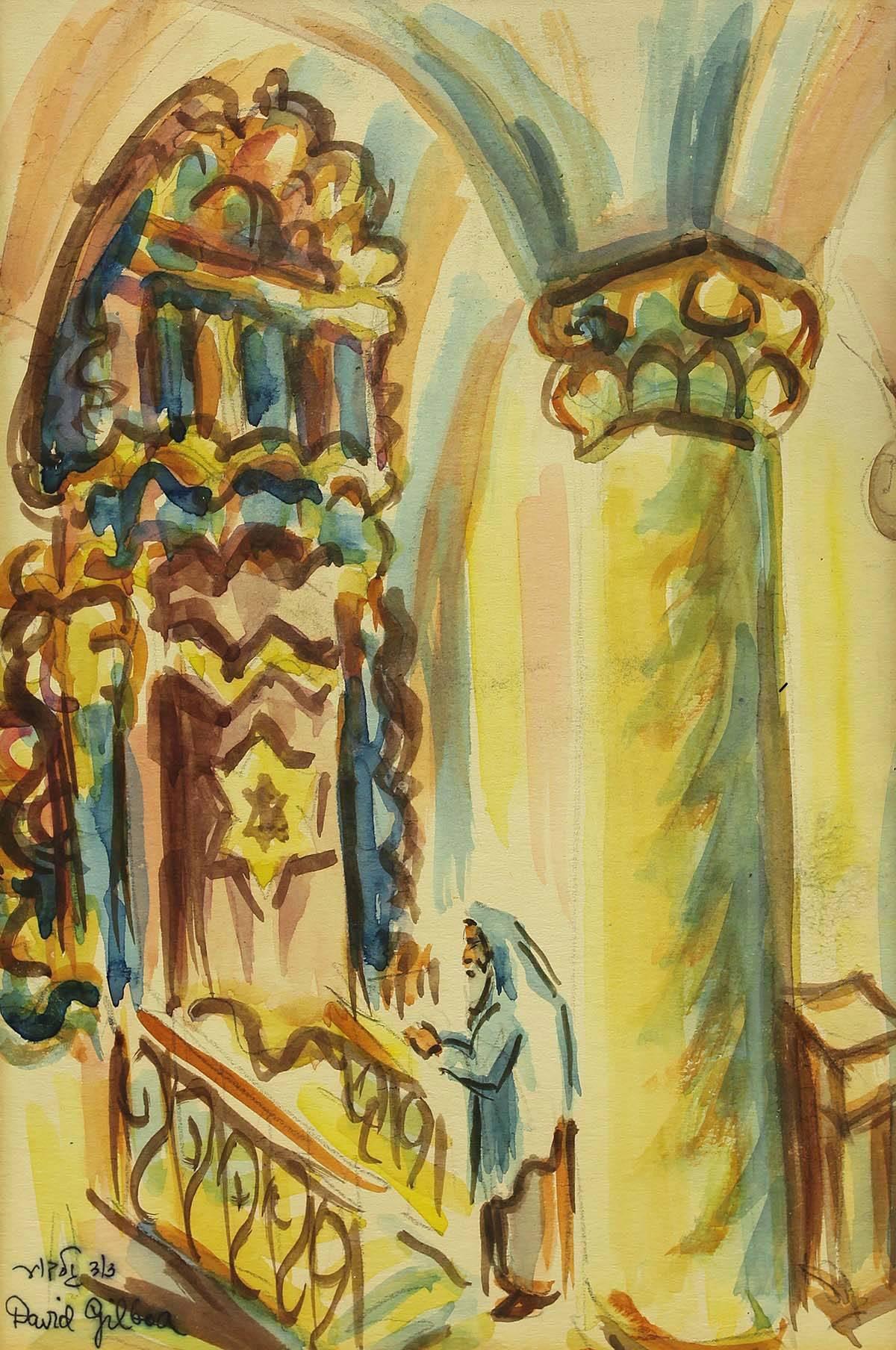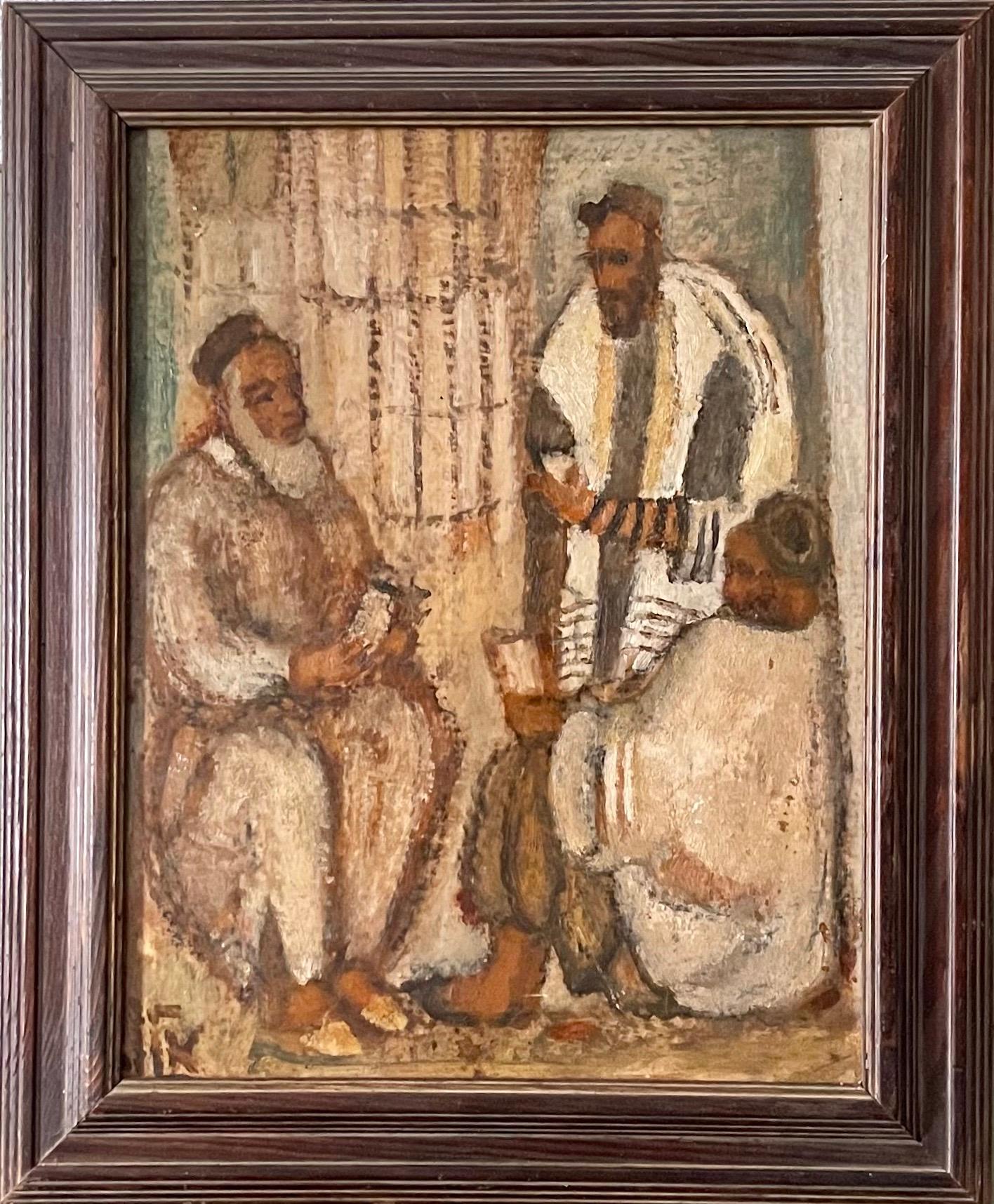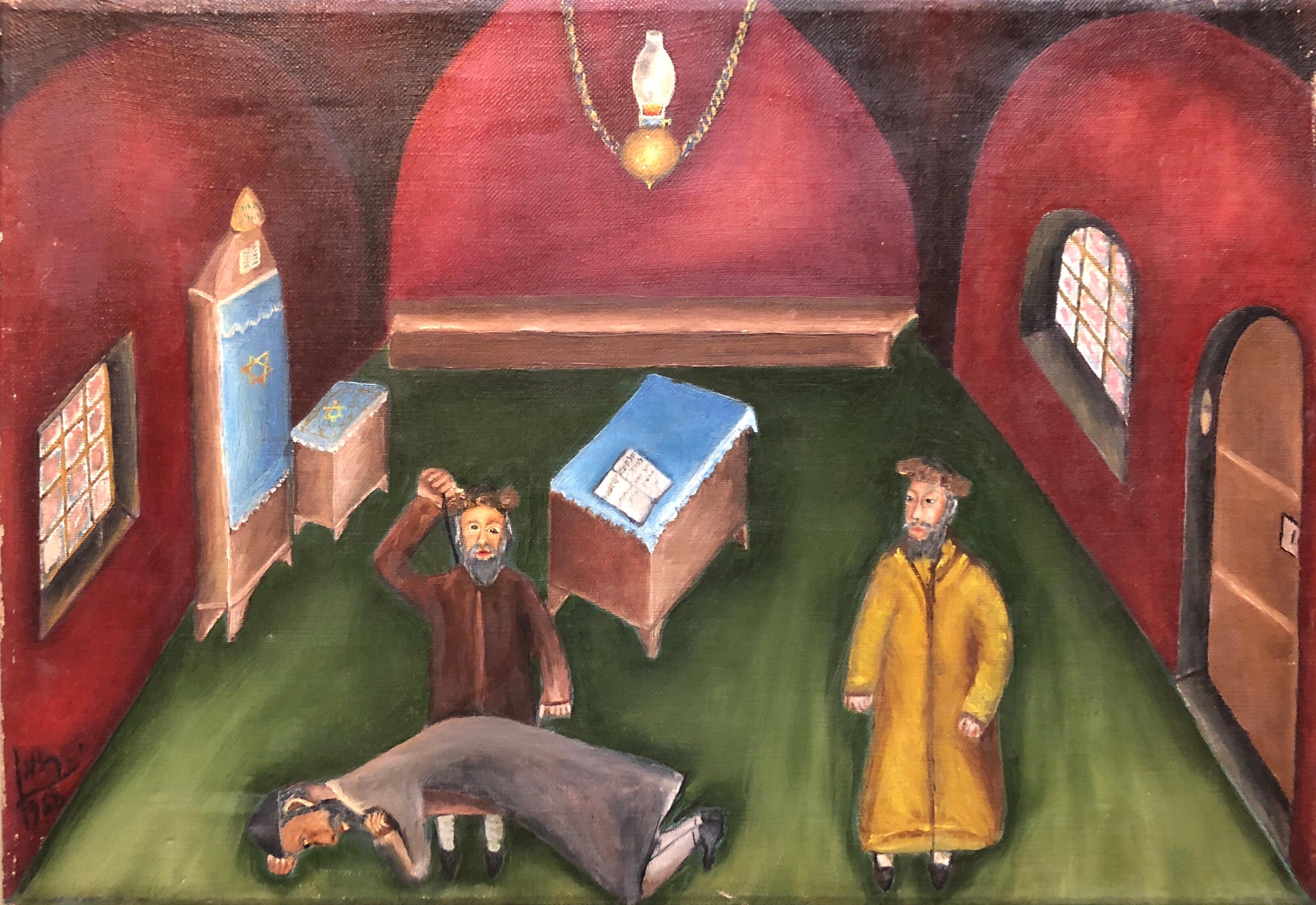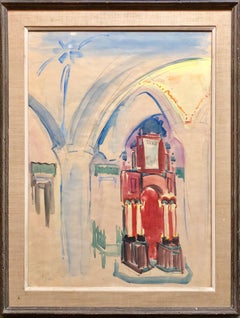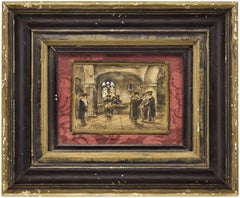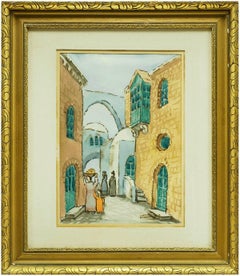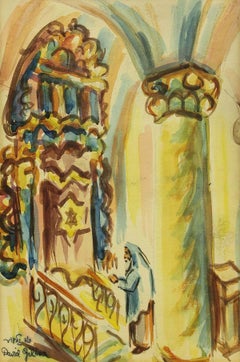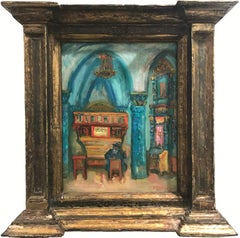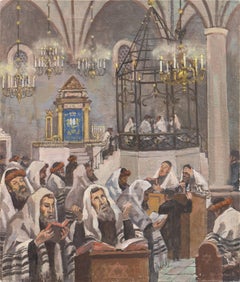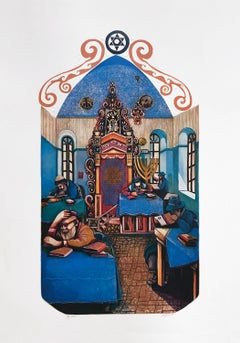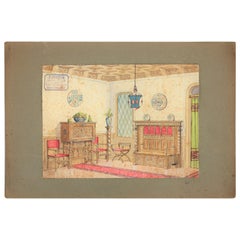Items Similar to Israeli Modernist Safed Synagogue Interior Folk Art Watercolor Painting
Want more images or videos?
Request additional images or videos from the seller
1 of 10
Zvi EhrmanIsraeli Modernist Safed Synagogue Interior Folk Art Watercolor Painting
$625
£474.24
€542.25
CA$872.96
A$970.61
CHF 506.80
MX$11,814.66
NOK 6,466.52
SEK 6,058.82
DKK 4,046.88
Shipping
Retrieving quote...The 1stDibs Promise:
Authenticity Guarantee,
Money-Back Guarantee,
24-Hour Cancellation
About the Item
In this piece the artist choice of colors is vibrant, and there is minimal blending of them. The artist takes a naive, Folk Art approach at rendering the subject simplifying the figures to basic geometric shapes.
Krakow, Poland, 1903 – Safed, Israel, 1993
Zvi Ehrman was a talented aquarellist who focused his work on Jewish subjects and landscape to Israel. He studied at the Art Academy of Krakow and taught art at the Hebrew Gymnasium in Krakow. He moved to Israel and became a prominent figure in the artist colony in Safed. Ehrman´s works are figurative and use soft pastel tones to capture the brilliance of the bright Israeli sun.
- Creator:Zvi Ehrman (1903 - 1993, Israeli, Polish)
- Dimensions:Height: 20.75 in (52.71 cm)Width: 16.75 in (42.55 cm)
- Medium:
- Movement & Style:
- Period:
- Condition:signature is very faint. frame has minor wear. size includes frame.
- Gallery Location:Surfside, FL
- Reference Number:Seller: 2251stDibs: LU38213146472
About the Seller
4.9
Platinum Seller
Premium sellers with a 4.7+ rating and 24-hour response times
Established in 1995
1stDibs seller since 2014
1,784 sales on 1stDibs
Typical response time: <1 hour
- ShippingRetrieving quote...Shipping from: Surfside, FL
- Return Policy
Authenticity Guarantee
In the unlikely event there’s an issue with an item’s authenticity, contact us within 1 year for a full refund. DetailsMoney-Back Guarantee
If your item is not as described, is damaged in transit, or does not arrive, contact us within 7 days for a full refund. Details24-Hour Cancellation
You have a 24-hour grace period in which to reconsider your purchase, with no questions asked.Vetted Professional Sellers
Our world-class sellers must adhere to strict standards for service and quality, maintaining the integrity of our listings.Price-Match Guarantee
If you find that a seller listed the same item for a lower price elsewhere, we’ll match it.Trusted Global Delivery
Our best-in-class carrier network provides specialized shipping options worldwide, including custom delivery.More From This Seller
View AllIsraeli Modernist Watercolor Painting Safed Synagogue Interior Bezalel School
By Mordechai Avniel
Located in Surfside, FL
Watercolor painting of Shul interior in Tzfas, Safed Israel.
MORDECHAI AVNIEL
Minsk, Belarus, b. 1900, d. 1989
Mordecai Dickstein (later Avniel) was born in 1900 in Minsk, present-day Belarus. He studied fine arts in Yekaterinburg, Russia (1913–19) and at the Bezalel Academy of Art and Design, Jerusalem (1923). Avniel immigrated to Palestine in 1921 where he first worked as a pioneer in citrus plantations near Petah Tikva. In 1923, at the urging of Boris Schatz, he went to Jerusalem to further his art studies at Bezalel. He later taught painting and sculpture at the school, and served a term as director of the Small Sculpture Section of the Sculpture Department (1924–28). From 1935 on, Avniel lived in Haifa. Avniel was also a lawyer and a founding partner of the Haifa firm Avniel, Salomon & Company.
Avniel regularly showed his work in group exhibitions of the Painters and Sculptors' Association of Israel. He was awarded the Herman Struck Prize (1952), Tenth Anniversary Prize for Watercolours, Ramat Gan (1958), Histadrut Prize (1961), and First Prize Haifa Municipality (1977). He represented Israel at the 1958 Venice Biennale and the 1962 International Art Seminar at Fairleigh Dickinson University. Avniel was a member of the Artists' Colony in Safed and maintained a studio on Mount Carmel.
Mordechai Avniel is best known for his deft and singular landscape work.
His works are held in numerous museums and collections both in Israel and abroad, including the Metropolitan Museum, New York and the Carnegie Institute, Pittsburgh, PA. Avniel's manipulations of light and colour share much with those of compatriot artists Shimshon Holzman and Joseph Kossonogi.
Education
1913-19 Art School of Katrinburg, Russia
1923 Bezalel School of Art, Jerusalem
Selected exhibitions:
2004: Our Landscape: Notes on Landscape Painting in Israel, University of Haifa Art Gallery, Haifa (online catalogue)
1965: Mordechai Avniel Retrospective, Haifa Municipality Museum of Modern Art, Haifa
1964: Galerie Synthèse, Paris
1962: New York University, New York
1961: Rina Gallery of Modern Art, Jerusalem
The Autumn Exhibition Rina Gallery, Jerusalem
Artists: Dedi Ben Shaul...
Category
20th Century Modern Interior Paintings
Materials
Paper, Watercolor
Interior of a Synagogue, Judaida Drawing, Watercolor, Gouache
By Ernst Oppler
Located in Surfside, FL
Ernst Oppler (9 September 1867 – 1 March 1929) was a German Impressionist painter and etcher born in Hanover.
Oppler at a meeting of the Berlin secession...
Category
20th Century Impressionist Interior Drawings and Watercolors
Materials
Watercolor, Gouache
Israeli Modernist Old City Jerusalem Landscape Folk Art Watercolor Painting
By Zvi Ehrman
Located in Surfside, FL
In this piece the artist choice of colors is vibrant, and there is minimal blending of them. The artist takes a naive, Folk Art approach at rendering the subject simplifying the figu...
Category
Mid-20th Century Modern Landscape Drawings and Watercolors
Materials
Paper, Watercolor
Synagogue Interior Safed, Israel
By David Gilboa
Located in Surfside, FL
David Gilboa (1910-1976). David Gilboa was born in Romania in 1910. He studied at Academy of Fine Art, Bucharest, Romania, during the years of 1927-29. He immigrated to Israel in 193...
Category
20th Century Modern Drawings and Watercolor Paintings
Materials
Watercolor
Synagogue Interior Jerusalem Modernist Israeli Judaica Oil Painting Rabbi Prayer
By Arieh Allweil
Located in Surfside, FL
ARIEH ALLWEIL (ARIE ALWEIL) 1901-1967
Galicia 1901-1967 Safed, Israel (Ukrainian/Polish/Israeli)
Arieh Allweil, born 1901, Galicia. Immigrated to Palestine in 1920. Studies: 1921-25...
Category
20th Century Modern Figurative Paintings
Materials
Canvas, Oil, Board
Israeli Judaica Folk Art Oil Synagogue Interior Malkos Lashes Erev Yom kippur
By Yitzchak Roman
Located in Surfside, FL
Yitzchak Roman, Israeli Folk Artist Painting and sculpture, born in Safed, 1913, known for his naive depictions of Jewish life and biblical scenes...
Category
20th Century Modern Figurative Paintings
Materials
Canvas, Oil
You May Also Like
"Synagogue Interior Scene with Figure" Post-Impressionist Oil Painting on Canvas
By Jacques Zucker
Located in New York, NY
An outstanding oil painting depicting a religious figure seated in a Synagogue with decorated columns and in between arches. The bright colors and quick brush strokes are what make t...
Category
20th Century Post-Impressionist Figurative Paintings
Materials
Canvas, Oil
'Interior of Synagogue with Rabbi', Polish Orthodox Judaica, Israel, Pentateuch
By Mieczyslaw Watorski
Located in Santa Cruz, CA
Signed lower right, 'M. Watorski' for Mieczyslaw Watorski (Polish, 1903 - 1979) and painted circa 1950.
This Polish history and landscape painter is particularly revered for his doc...
Category
1940s Modern Interior Paintings
Materials
Canvas, Oil
YASHIVA IN JERUSALEM (JUDAICA ART)
By Amram Ebgi
Located in Aventura, FL
Embossed lithograph with foil stamping on paper. Hand signed and numbered by the artist. From the edition of 300.
Artwork is in excellent condition. Certificate of authenticity in...
Category
Late 20th Century Contemporary Figurative Prints
Materials
Foil
$100 Sale Price
50% Off
Interior Scene Original Watercolor, Ink and Gouache Drawing, Spain, 1930s
Located in Barcelona, ES
Spanish Colonial Indoor home scene. Original watercolor, ink and gouache drawing on vellum paper, Project for a home decoration. Cabinet maker archives stamp top Lef: 'J. Anguera. Ca...
Category
Vintage 1930s Spanish Spanish Colonial Drawings
Materials
Other
Portuguese 1944 Watercolor Sunday Morning Mass
Located in Santa Monica, CA
Portuguese 1944 Watercolor Sunday Morning Mass.
Category
Vintage 1940s Portuguese Paintings
Materials
Glass, Wood
$637 Sale Price
20% Off
"Song of Songs Illustration" Old Testament, Watercolor
Located in Detroit, MI
SALE ONE WEEK ONLY
"Song of Songs Illustration" renders an important bibilical story that is celebrated during Jewish Passover. Song of Solomon, also called Canticle of Canticles, or Song of Songs, an Old Testament...
Category
Mid-20th Century Other Art Style Animal Drawings and Watercolors
Materials
Paper, Watercolor
More Ways To Browse
Used Safes Safes
Israeli Modern Paintings
Israel Landscape Painting
Israeli Landscape Paintings
Naive Folk Art
Mid Century Israeli Art
Synagogue Painting
Jewish Synagogue
Jewish Folk Art
Safed Israel
Justin Faivre
Louis Vuitton Recto Verso Black
Maria Ada Gianni
Nestor Fruge
Occult Geometry
Paintings Robin Hoods Bay
Rothenburg Tauber
Stephen Cox
